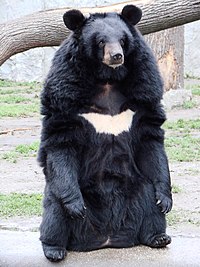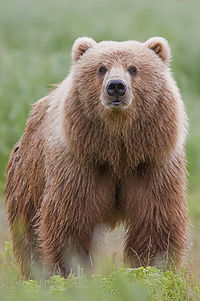
Bile bears, sometimes called battery bears, are bears kept in captivity to harvest their bile, a digestive fluid produced by the liver and stored in the gallbladder, which is used by some traditional Asian medicine practitioners.[2][3][4] It is estimated that 12,000 bears are farmed for bile[5] in China, South Korea, Laos, Vietnam, and Myanmar.[6][7][8][9][10] Demand for the bile has been found in those nations as well as in some others, such as Malaysia[11] and Japan.[12]
The bear species most commonly farmed for bile is the Asiatic black bear (Ursus thibetanus),[13] although the sun bear (Helarctos malayanus), brown bear (Ursus arctos) and every other East Asian bear species are also used (the only exception being the giant panda which does not produce UDCA).[14][15][16] Both the Asiatic black bear and the sun bear are listed as Vulnerable on the Red List of Threatened Animals published by the International Union for Conservation of Nature.[13][14] They were previously hunted for bile but factory farming has become common since hunting was banned in the 1980s.[17]
The bile can be harvested using several techniques, all of which require some degree of surgery, and may leave a permanent fistula or inserted catheter. A significant proportion of the bears die because of the stress of unskilled surgery or the infections which may occur.
Farmed bile bears are housed continuously in small cages which often prevent them from standing or sitting upright, or from turning around. These highly restrictive cage systems and the low level of skilled husbandry can lead to a wide range of welfare concerns including physical injuries, pain, severe mental stress and muscle atrophy. Some bears are caught as cubs and may be kept in these conditions for up to 30 years.[18]
The value of the bear products trade is estimated as high as $2 billion.[19][20] The practice of factory farming bears for bile has been extensively condemned, including by Chinese physicians.[21]
- ^ Asian Animal Protection Network Archived July 22, 2012, at the Wayback Machine. Aapn.org. Retrieved on 2011-09-26.
- ^ Czaja, Olaf (2019-03-04). "The use of insects in Tibetan medicine". Centre pour l'Édition Électronique Ouverte (50). doi:10.4000/emscat.3994. ISSN 0766-5075.
- ^ SAHA, GOUTAM KUMAR; MAZUMDAR, SUBHENDU (2017-07-01). WILDLIFE BIOLOGY: AN INDIAN PERSPECTIVE. PHI Learning Pvt. Ltd. ISBN 978-81-203-5313-8.
- ^ Cite error: The named reference
Fengwas invoked but never defined (see the help page). - ^ Cite error: The named reference
Hancewas invoked but never defined (see the help page). - ^ Gong, J. & Harris, R. B. (2006). "The status of bears in China". Understanding Asian Bears to Secure Their Future. Japan Bear Network (compiler), Ibaraki, Japan. pp. 96–101.
- ^ MacGregor, F. (2010). "Inside a bear bile farm in Laos". The Daily Telegraph. London.
- ^ Jacobs, A. (2013). "Folk remedy extracted from captive bears stirs furor in China". The New York Times. Retrieved October 8, 2013.
- ^ Gwang-lip, M. (2009). "Vietnamese urge Koreans not to travel for bear bile". Korea JoongAng Daily. Archived from the original on 2012-07-09.
{{cite web}}: CS1 maint: unfit URL (link) - ^ Black, R. (2007). "BBC Test kit targets cruel bear trade". BBC News. Archived from the original on 2009-01-15. Retrieved 2010-01-01.
- ^ "Pills, Powders, Vials and Flakes: the bear bile trade in Asia" (PDF). Traffic. 2011.
- ^ "Bear Bile Farming". Animals Asia. Retrieved 2020-10-23.
- ^ a b Garshelis, D. & Steinmetz, R. (2020). "Ursus thibetanus". IUCN Red List of Threatened Species. 2020: e.T22824A166528664. doi:10.2305/IUCN.UK.2020-3.RLTS.T22824A166528664.en. Retrieved 12 November 2021.
- ^ a b Scotson, L.; Fredriksson, G.; Augeri, D.; Cheah, C.; Ngoprasert, D. & Wai-Ming, W. (2018) [errata version of 2017 assessment]. "Helarctos malayanus". IUCN Red List of Threatened Species. 2017: e.T9760A123798233. doi:10.2305/IUCN.UK.2017-3.RLTS.T9760A45033547.en.
- ^ McLellan, B.N.; Proctor, M.F.; Huber, D. & Michel, S. "Ursus arctos". IUCN Red List of Threatened Species. 2017: e.T41688A121229971. doi:10.2305/IUCN.UK.2017-3.RLTS.T41688A121229971.en. Retrieved 12 November 2021.
- ^ Feng, Yibin; Siu, Kayu; Wang, Ning; Ng, Kwan-Ming; Tsao, Sai-Wah; Nagamatsu, Tadashi; Tong, Yao (2009-01-12). "Bear bile: dilemma of traditional medicinal use and animal protection". Journal of Ethnobiology and Ethnomedicine. 5: 2. doi:10.1186/1746-4269-5-2. PMC 2630947. PMID 19138420.
- ^ Bacon, H. (2008). "Implications of bear bile farming". Veterinary Times.
- ^ "End Bear Bile Farming". Animals Asia Foundation. Retrieved 2017-09-29.
- ^ Cite error: The named reference
Guinnesswas invoked but never defined (see the help page). - ^ Kavoussi, Ben (March 24, 2011). "Asian Bear Bile Remedies: Traditional Medicine or Barbarism?". Science Based medicine. Retrieved February 10, 2016.
- ^ "Chinese doctors to call for 'cruel' bear farms to be closed". The Daily Telegraph. Aug 28, 2011. Retrieved February 10, 2016.


